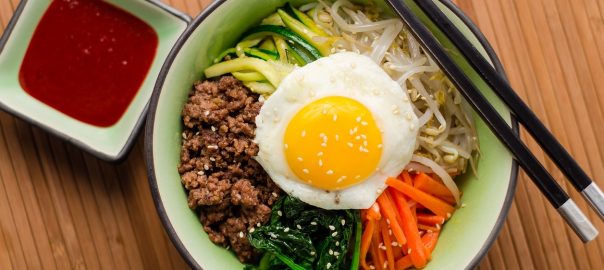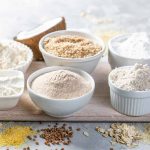
Korean Cooking – Low Carb & Keto Friendly
Cooking Korean – The Basic Dishes
Korean food is rapidly growing in popularity across North America. It all started with Korean BBQ (often abbreviated to “KBBQ”), which quickly opened the door for restaurants to serve other Korean staple dishes such as Bulgogi, Kimchi and Bibimbap right alongside ramen shops, sushi spots and other popular East Asian eateries.
If you have tried Korean food and are wondering how you can incorporate those ferment-y, spicy and savoury dishes into your low carb or keto diet, we’ve got you covered in this article! Or, if you’ve never tried any of these dishes, learn about this cultural uprising and how to make easy Korean recipes at home for the whole family to enjoy.
What is Korean Food?
Korean cuisine has undergone a unique evolution over centuries of sociopolitical, economic and agricultural changes. Consumption of meat, especially by the middle class, increased as the country became more industrialized. During war periods, inexpensive meat products such as Spam meat and hot dogs made their way into Korean cuisine from American army bases, and do not seem to be leaving any time soon! One of the most popular soup dishes in Korea is Army Stew, or Budae Jjigae, a fusion stew that combines American ingredients, such as canned ham, into a traditional Korean stew base.
Korean meals usually involve a diverse spread of individual dishes and ingredients, meant to be eaten all at once rather than in a sequence of courses, as seen in Western cuisines. Fermented foods are also commonplace at any meal. Fermentation became popular in Korea due to the long, cold winters that required a way to preserve vegetables and seafoods. However, fermented foods such as Kimchi, gochujang sauce and jeotgal (fermented seafood) are consumed year-round! Fermentation provides a tangy, salty flavour to dishes as well as healthy probiotic bacteria that can improve gut health and help with digestion.
Soups and Stews
Soups and stews are considered main dishes in Korean cuisine. Traditional jjigae, meaning stew, usually contain a variety of vegetables, meat or tofu, egg, all submerged in a broth that is usually seasoned with a fermented sauce, such as gochujang. Try this low carb take on traditional Korean Kimchi Stew with Chicken – a super simple one-pot meal that is both comforting and healthy!
Kimchi
No Korean meal is complete without kimchi! This fermented vegetable dish is made with cabbages and radishes – both of which are low in carbs, so this is totally a keto-friendly side dish or flavouring agent. Kimchi also traditionally contains garlic, ginger, sweet onions, chili powder, brining salt and can include fermented seafood, too.
Due to its widespread popularity, kimchi can often be found in your local supermarket in the same aisle as other fermented or preserved foods. If you are willing to get crafty in the kitchen, you could also make your own kimchi at home. Here’s a recipe for simple homemade cabbage kimchi. Making your own kimchi is not only cheaper, but it’s also a lot simpler than it sounds. Impress your friends and family with this flavourful condiment that will last for ages!
Noodles
Noodles usually form the base of many bowls and side dishes in Korean cuisines. However, noodles are not exactly low-carb friendly. We recommend using a konjac or shirataki noodle instead if you are re-creating Korean dishes at home!
In Korean culture, rice is also eaten with every meal to accompany the other meat and vegetable dishes. Miracle Noodle Shirataki Rice Substitute is the perfect low carb replacement for this, with almost no calories or carbs. The glucomannan fibre content will keep you feeling full, as well as help lower cholesterol and blood sugar levels. Not to mention, shirataki and konjac noodles are great for gut health and digestive regularity – paired with kimchi, it’s the ultimate dish for days when you are feeling bloated or backlogged. You can also substitute rice with cauliflower for a similar texture and appearance. Try this classic Korean Bibimbap with Cauliflower Rice.
Meat
Unlike Western culture, meat usually appears in banchan, or side dishes, in Korean cuisine. It is typically cooked over a charcoal grill that sits in the middle of a table. Tofu is also used sometimes as it was introduced with vegetarian Buddhist cuisine many centuries ago.
While you might not have a Korean BBQ grill sitting in the centre of your table at home, it is still easy to make KBBQ-style recipes at home. Simply swap out some of the ingredients in the typically sweet marinades with low carb options. You’ll need a brown sugar replacement, such as this one from Swerve, or Lakanto Golden Monk Fruit Sweetener. Instead of sriracha or a sweetened hot sauce, opt for plain red chili paste, fresh chili peppers or a dry spice seasoning. Try this recipe we found for Crock Pot Low Carb & Keto-Friendly Korean BBQ Beef Ribs! You can use the marinade from this recipe in any dish – try it with chicken, fish, pork or tofu! You could also grill your meat on the stove or barbeque it outdoors.
Also, if you find yourself at a KBBQ establishment, here are some tips for how you can stick to your keto diet:
- Choose plain meats and seafoods that are prepared without marinades (such as bulgogi and galbi), as these usually contain sugars, honey and fruit juices.
- Choose side dishes, or banchan, such as kimchi, rolled omelette trips, seasoned greens and broth-based soups without noodles.
- Dipping sauce made from sesame oil, salt and pepper is totally safe (and delicious)!
- Ask for lettuce to build your own KBBQ keto-friendly wraps.
- Avoid obvious high carb side dishes and desserts such as rice, noodles, dumplings and sweets.
Sauces and Marinades
The sauces and marinades, or jang, that you find in Korean cuisine are truly special and one of the things that make this cuisine so unique. The blend of spicy, sour and sweet flavours can transform any meat or seafood. One of the most popular sauces that has even made its way into gourmet cooking is gochujang sauce, a fermented chili paste. Making jang is a highly revered, almost ceremonial, process in Korean households. The taste, the day on which it is made and the container in which it is stored are all important elements for making an auspicious sauce.
Gochujang traditionally contains sugar and glutinous rice – making it a hard sell for low carb and keto dieters. That said, it’s easy to make a low carb version of this for yourself at home! Here are a few simple ingredients that you will need to make a gluten-free, sugar-free low carb gochujang sauce:
- Water
- Korean hot pepper (gochugaru) powder. You could also use your own preferred chili powder.
- Miso paste
- Salt
- Rice wine vinegar
- Lakanto Maple-Flavoured Monk Fruit Syrup
Whisk all of these ingredients together in a saucepan over low heat. Once the sauce thickens, it’s done! Store it in an airtight jar in your fridge and save it for future marinades.
Savory Pancakes
Korean savory pancakes, also known as jeon, are traditionally prepared for the Lunar New Year and Harvest Festivals, but they are regularly consumed year-round. There are many different varieties of jeon, and despite their resemblance to pancakes, they are really all about the fillings. Typically, chopped seafood, meat, vegetables and kimchi are fried together in a batter of flour and eggs and served with a spicy soy-based dipping sauce. Jeon is usually enjoyed as a side dish – but these savoury pancakes also make a great breakfast, lunch or dinner all on their own!
In order to make these pancakes keto-friendly, substitute the traditional rice and wheat flour blend for a low carb alternative, such as coconut flour, almond flour, flaxseed meal or finely minced cauliflower. Here is a low carb savoury pancake recipe we found that uses coconut flour and psyllium husk for an added boost of fibre! This keto scallion pancakes recipe uses cauliflower and flaxseed meal instead. Both of these recipes show you how to make the batter for the pancakes, so make sure to add in some pancake fillings to complete the meal as traditionally prepared. You should cook your meat (shrimp, bacon or shredded chicken are all good options), veggies and kimchi in the pan before adding the batter to bind everything together. These recipes make one large pancake that can be cut into smaller pieces, perfect for dipping in a spicy, savoury sauce.
You can make a Korean-style dipping sauce with the following ingredients:
- 2 tablespoons of soy sauce or coconut aminos
- 1 tablespoon of rice vinegar
- 1 tablespoon of brown sugar replacement
- 1 teaspoon or red chili pepper flakes
- ½ teaspoon of toasted sesame seeds
- ½ teaspoon of onion powder
- ½ teaspoon of garlic powder
Start Cooking Korean Today!
Korean food boasts delicious and versatile flavours that can easily be modified for a keto or low carb diet. If you enjoyed learning about Korean food or tried any of the recipes in this article, we’d love to know! Tag us on Facebook or Instagram with your thoughts and photos.
We also love to stay connected with our Weekly Newsletters for updates on the latest products and special sales. And don’t forget to leave us a Google Review with your Low Carb Grocery shopping experience(s)!






